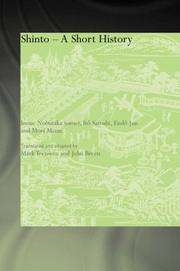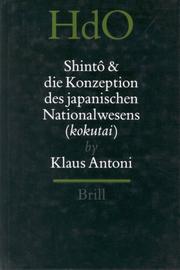| Listing 1 - 10 of 23 | << page >> |
Sort by
|
Book
ISBN: 9780190621711 0190621710 9780190621735 0190621745 0190621729 0190621737 9780190621742 9780190621728 Year: 2017 Publisher: New York
Abstract | Keywords | Export | Availability | Bookmark
 Loading...
Loading...Choose an application
- Reference Manager
- EndNote
- RefWorks (Direct export to RefWorks)
Helen Hardacre offers a sweeping, comprehensive history of Shinto, the tradition that is practiced by some 80 percent of the Japanese people and underlies the institution of the Emperor.
Shinto. --- Shinto --- History. --- Histoire --- J1970 --- Japan: Religion -- Shintō -- history --- J1910 --- Japan: Religion -- Shintō -- general and history --- Shintō --- Shinto - History.
Book
ISBN: 3700129890 9783700129899 Year: 2001 Volume: 38 687 Publisher: Wien Österreichische Akademie der Wissenschaften
Abstract | Keywords | Export | Availability | Bookmark
 Loading...
Loading...Choose an application
- Reference Manager
- EndNote
- RefWorks (Direct export to RefWorks)
Yoshida Shinto --- Shinto --- Doctrines --- History --- Histoire --- Yoshida, Kanetomo, --- Doctrines. --- History. --- Yoshida Shintō --- Yoshida Shinto - Doctrines. --- Yoshida Shinto - History. --- Shinto - History - To 1185.
Book
ISBN: 9781405155168 9781405155151 1405155159 1405155167 Year: 2010 Volume: *2 Publisher: Chichester Wiley-Blackwell
Abstract | Keywords | Export | Availability | Bookmark
 Loading...
Loading...Choose an application
- Reference Manager
- EndNote
- RefWorks (Direct export to RefWorks)
Shinto --- History. --- J1910 --- Japan: Religion -- Shintō -- general and history --- History --- Shinto - History.

ISBN: 0415311799 0415319137 1134384629 1280062533 0203462882 1134384610 9780203462881 0203340825 9780203340820 9780415311793 9780415319133 9781134384570 9781134384617 9781134384624 Year: 2003 Publisher: London New York RoutledgeCurzon
Abstract | Keywords | Export | Availability | Bookmark
 Loading...
Loading...Choose an application
- Reference Manager
- EndNote
- RefWorks (Direct export to RefWorks)
Shinto - A Short History provides an introductory outline of the historical development of Shinto from the ancient period of Japanese history until the present day. Shinto does not offer a readily identifiable set of teachings, rituals or beliefs; individual shrines and kami deities have led their own lives, not within the confines of a narrowly defined Shinto, but rather as participants in a religious field that included Buddhist, Taoist, Confucian and folk elements. Thus, this book approaches Shinto as a series of historical 'religious systems' rather than attempting to identify
Shinto --- History. --- Histoire --- J1970 --- Japan: Religion -- Shintō -- history --- J1910 --- Japan: Religion -- Shintō -- general and history --- Shintō --- History --- Religion --- Religious history --- Japan --- kami --- Buddhism --- Shinto identity --- shintoism --- japanese religions
Book
ISBN: 9781350066540 9781474271080 1474271081 1350066540 Year: 2018 Publisher: London Bloomsbury Academic
Abstract | Keywords | Export | Availability | Bookmark
 Loading...
Loading...Choose an application
- Reference Manager
- EndNote
- RefWorks (Direct export to RefWorks)
"Yijiang Zhong analyses the formation of Shinto as a complex and diverse religious tradition in early modern Japan, 1600-1868. Highlighting the role of the god Okuninushi and the mythology centered on the Izumo Shrine in western Japan as part of this process, he shows how and why this god came to be ignored in State Shinto in the modern period. In doing so, Zhong moves away from the traditional understanding of Shinto history as something completely internal to the nation of Japan, and instead situates the formation of Shinto within a larger geopolitical context involving intellectual and political developments in the East Asian region and the role of western colonial expansion. The Origin of Modern Shinto in Japan draws extensively on primary source materials in Japan, many of which were only made available to the public less than a decade ago and have not yet been studied. Source materials analysed include shrine records and object materials, contemporary written texts, official materials from the national and provincial levels, and a broad range of visual sources based on contemporary prints, drawings, photographs and material culture"--
J1912.19 --- J1910.60 --- J1910.70 --- Japan: Religion -- Shintō -- history -- Kinsei, Edo, Tokugawa period, early modern (1600-1867) --- Japan: Religion -- Shintō -- history -- Kindai (1850s- ), bakumatsu, Meiji, Taishō --- J1912.90 --- Shinto --- Ōkuninushi no kami. --- History --- Japan --- Religion --- HISTORY --- RELIGION --- Religion. --- Schintoismus. --- Shinto. --- Staat. --- Ōkuninushi no kami. --- Buddhism --- History. --- Shintoism. --- Izumo-Schrein. --- To 1868. --- Japan. --- Japan: Religion -- Shintō -- kami

ISBN: 9004103163 9004488499 Year: 1998 Volume: 8 Publisher: Leiden Brill
Abstract | Keywords | Export | Availability | Bookmark
 Loading...
Loading...Choose an application
- Reference Manager
- EndNote
- RefWorks (Direct export to RefWorks)
Shinto and state --- Kokutai --- Shinto et Etat --- 299.52 --- J1942 --- J1970.70 --- J1008 --- State and Shinto --- State, The --- Emperors --- Godsdiensten van Japan. Shintoisme --- Japan: Religion -- Shintō -- relation with politics and state, Shintō as national polity (kokutai) --- Japan: Religion -- Shintō -- history -- Kindai (1850s- ), bakumatsu, Meiji, Taishō --- Japan: Philosophy -- history --- 299.52 Godsdiensten van Japan. Shintoisme --- J1910.70 --- J1917.70 --- Japan: Religion -- Shintō -- relations -- State, state Shintō --- J1910.60 --- Japan: Religion -- Shintō -- history -- Kinsei, Edo, Tokugawa period, early modern (1600-1867) --- Shintō et Etat
Book
ISBN: 9783700174004 3700174004 Year: 2013 Volume: 840 78 Publisher: Wien Österreichische Akademie der Wissenschaften
Abstract | Keywords | Export | Availability | Bookmark
 Loading...
Loading...Choose an application
- Reference Manager
- EndNote
- RefWorks (Direct export to RefWorks)
Shinto is often regarded as Japan’s indigenous religion retaining archaic elements of animism and nature worship. At the same time, Shinto is sometimes seen as nothing else than a nationalistic political ideology. After all, in 1868 Japan turned into a modern nation state and worship at Shinto shrines became a national cult. This so-called State Shinto was eventually abolished under the Allied Occupation in 1946 but the historical links between Shinto and Japanese nationalism led to an ambiguous evaluation of Shinto not only at the popular level but also at the level of scientific research. The present volume comprises eight essays by leading experts of Japanese intellectual history from Japan, Europe, and the USA who tackle this issue from the point of view of research history: What is the impact of State Shinto on Shinto research before and after the Second World War? How did Japanese and international scholars contribute and/or react to the ideological framework of Japanese nationalism? How did nationalist discourses of other countries (in particular German National Socialism) influence the representation of Shinto? As each essay addresses these issues from a specific angle, it becomes clear that there never was just one ideology of State Shinto. Moreover, the emphasis on Shinto ritual by the political authorities weakened the significance of academic research of Shinto as a tool of propaganda. Regarding the concept of Shinto proper, the impact of modern, “westernized” religious studies seems at least as important as traditional, “nativist” approaches.
Democracy --- Constitutional history --- Emperors --- Démocratie --- Histoire constitutionnelle --- Empereurs --- History. --- Histoire --- Japan --- Japon --- Economic policy --- Politics and government --- Politique économique --- Politique et gouvernement --- Shinto and politics --- Shinto --- History --- Religion --- J1940.50 --- J1970.80 --- Japan: Religion -- Shintō -- study and teaching --- Japan: Religion -- Shintō -- history -- Gendai, modern (1926- ), Shōwa, 20th century --- J1911.50 --- J1910.80 --- Démocratie --- Politique économique --- Shinto and politics - Japan --- Shinto - History --- Japan - Religion - History
Book
ISBN: 0691020523 0691073481 9780691073484 Year: 1991 Publisher: Princeton Princeton university press
Abstract | Keywords | Export | Availability | Bookmark
 Loading...
Loading...Choose an application
- Reference Manager
- EndNote
- RefWorks (Direct export to RefWorks)
Helen Hardacre, a leading scholar of religious life in modern Japan, examines the Japanese state's involvement in and manipulation of shinto from the Meiji Restoration to the present. Nowhere else in modern history do we find so pronounced an example of government sponsorship of a religion as in Japan's support of shinto. How did that sponsorship come about and how was it maintained? How was it dismantled after World War II? What attempts are being made today to reconstruct it? In answering these questions, Hardacre shows why State shinto symbols, such as the Yasukuni Shrine and its prefectural branches, are still the focus for bitter struggles over who will have the right to articulate their significance. Where previous studies have emphasized the state bureaucracy responsible for the administration of shinto, Hardacre goes to the periphery of Japanese society. She demonstrates that leaders and adherents of popular religious movements, independent religious entrepreneurs, women seeking to raise the prestige of their households, and men with political ambitions all found an association with shinto useful for self-promotion; local-level civil administrations and parish organizations have consistently patronized shinto as a way to raise the prospects of provincial communities. A conduit for access to the prestige of the state, shinto has increased not only the power of the center of society over the periphery but also the power of the periphery over the center.
299.52 --- 322 <520> --- J1917.70 --- J1910.70 --- J1910.80 --- Shinto --- -Shinto --- -Shinto and state --- State and Shinto --- State, The --- 299.52 Godsdiensten van Japan. Shintoisme --- Godsdiensten van Japan. Shintoisme --- Religions --- 322 <520> Godsdienstige tolerantie. Godsdienstpolitiek--Japan --- Godsdienstige tolerantie. Godsdienstpolitiek--Japan --- Japan: Religion -- Shintō -- relations -- State, state Shintō --- Japan: Religion -- Shintō -- history -- Kindai (1850s- ), bakumatsu, Meiji, Taishō --- Japan: Religion -- Shintō -- history -- Gendai, modern (1926- ), Shōwa, 20th century --- History --- -History --- -299.52 --- Shinto et Etat --- Sjinto en Staat --- Shinto and state. --- S35/1000 --- #SML: De Weirdt --- Japan--Religion --- -Shinto and state. --- Shinto -- History -- 1945 --- -Shinto -- History -- 1868-1945. --- Shinto -- History -- 1945-. --- Shinto -- History -- 1868-1945. --- Shinto and state --- 1868-1945 --- 1945 --- Allied Occupation. --- Buddhism. --- Christianity. --- Department of Divinity. --- Great Promulgation Campaign. --- Hirata Atsutane. --- Home Ministry. --- Imperial Household Ministry. --- Ise Grand Shrines. --- Iwakura Tomomi. --- Izumo Shrine. --- Jingūkyō. --- Kigensetsu. --- Meiji Restoration. --- Ministry of Education. --- Nakasone Yasuhiro. --- National Learning. --- Pantheon Dispute. --- Tanaka Yoritsune. --- Tsuwano Domain. --- confraternities. --- doctrine. --- emperor. --- festival. --- funerals. --- preaching. --- sacerdotal lineages. --- shrines. --- vestments. --- village assemblies. --- women ministers. --- Ōkuni Takamasa. --- -Staat --- Religion --- Shintoismus. --- Staat. --- Schintoismus. --- Religion. --- Religion, Primitive --- Atheism --- Irreligion --- Theology --- Staat --- Japan. --- al-Yābān --- Giappone --- Government of Japan --- Iapōnia --- I︠A︡ponii︠a︡ --- Japam --- Japani --- Japão --- Japon --- Japonia --- Japonsko --- Japonya --- Jih-pen --- Mư̄ang Yīpun --- Nihon --- Nihon-koku --- Nihonkoku --- Nippon --- Nippon-koku --- Nipponkoku --- Prathēt Yīpun --- Riben --- State of Japan --- Yābān --- Yapan --- Yīpun --- Zhāpān --- Япония --- اليابان --- يابان --- 日本 --- 日本国 --- Shinto - History - 1868-1945. --- Shinto - History - 1945 --- Jepun --- Yapon --- Yapon Ulus --- I︠A︡pon --- Япон --- I︠A︡pon Uls --- Япон Улс --- Pseudoreligion --- Schintoismus --- Shintoismus --- Japan --- Land --- Staatswesen --- Staaten --- Politisches System --- Fiskus --- Empire du Japon --- Zen-Nihon --- Zenkoku --- Dainihon --- Dainippon --- Japão --- Japaner --- -Japan. --- -History -

ISBN: 0810840162 Year: 2002 Volume: 38 Publisher: Lanham Scarecrow
Abstract | Keywords | Export | Availability | Bookmark
 Loading...
Loading...Choose an application
- Reference Manager
- EndNote
- RefWorks (Direct export to RefWorks)
Shinto --- Japanese language --- Japonais (Langue) --- Dictionaries --- English --- Dictionnaire anglais --- Dictionnaires anglais --- J1940.60 --- J1970 --- -Shinto --- -Religions --- Koguryo language --- Japan: Religion -- Shintō -- reference works --- Japan: Religion -- Shintō -- history --- Japanese --- -Japan: Religion -- Shintō -- reference works --- J1910 --- Japan: Religion -- Shintō -- general and history --- J1911.60 --- Shintō --- Religions --- Dictionaries.
Multi
ISBN: 9073782783 Year: 1996 Publisher: Leiden Research school CNWS
Abstract | Keywords | Export | Availability | Bookmark
 Loading...
Loading...Choose an application
- Reference Manager
- EndNote
- RefWorks (Direct export to RefWorks)
J1954.20 --- J1970 --- Japan: Religion -- Shintō -- sects -- Ise shintō (Watarai shintō, Jingūkyō) --- Japan: Religion -- Shintō -- history --- Theses --- J1910 --- Japan: Religion -- Shintō -- general and history --- J1913.20 --- Japan: Religion -- Shintō -- sects and schools -- traditional -- Ise shintō, Watarai shintō --- J1918.48 --- Japan: Religion -- Shintō -- shrines and pilgrimage -- Kansai and Kinki -- Mie prefecture (Iga, Shima, Ise)
| Listing 1 - 10 of 23 | << page >> |
Sort by
|

 Search
Search Feedback
Feedback About UniCat
About UniCat  Help
Help News
News